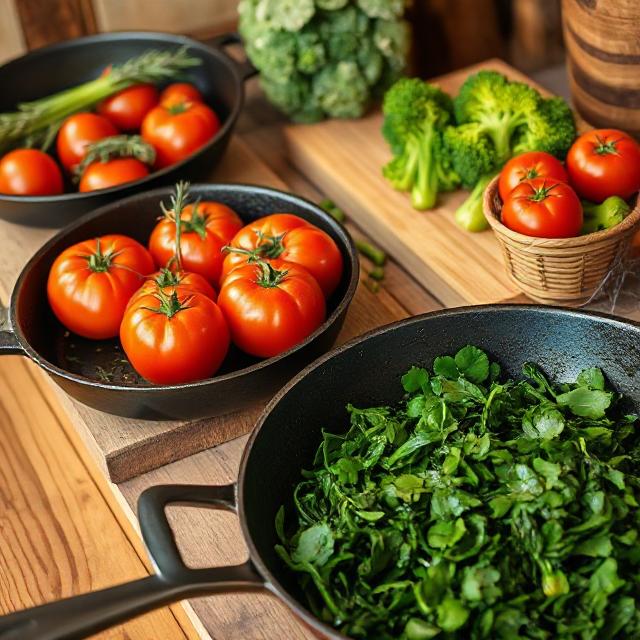
Table of Contents
Does Cooking Destroy Nutrients? What Science Says
“Raw is always better.” You’ve likely heard that before, but is it really true?
The relationship between cooking and nutrients is far more complex than most food myths suggest. While it’s true that some vitamins degrade with heat, cooking can also enhance the bioavailability of other nutrients, deactivate anti-nutrients, and even create new beneficial compounds.
This article breaks down the science of how cooking affects nutrient retention, absorption, and overall health—helping you make smarter, evidence-based decisions in your kitchen.
🔬 What Are Nutrients, and Why Cooking Affects Them
Nutrients fall into two main categories:
- Macronutrients: protein, fat, and carbohydrates
- Micronutrients: vitamins and minerals
Cooking generally doesn’t change macronutrient content dramatically (unless high heat degrades fats or sugars). However, micronutrients—especially water-soluble vitamins—are more sensitive to temperature, pH, and oxygen exposure.
🔥 Nutrients Lost During Cooking
1. Water-Soluble Vitamins
These are the most vulnerable to heat, especially in boiling:
- Vitamin C: One of the most sensitive. Up to 50–80% lost during boiling or long roasting.
- B vitamins: Including B1 (thiamine), B5 (pantothenic acid), B6, and folate. Easily leached into water or degraded by heat.
Boiling is the main culprit, especially when the cooking water is discarded. To preserve these nutrients:
- Steam instead of boil
- Use shorter cooking times
- Cook with minimal water
2. Mineral Leaching
Minerals like potassium, magnesium, and calcium are not destroyed by heat, but can leach into water during boiling or soaking. If you discard the water, you lose the nutrients.
🔬 Nutrients Enhanced by Cooking
Surprisingly, many important nutrients become more bioavailable—easier to absorb—after cooking.
1. Fat-Soluble Vitamins
- Vitamin A (beta-carotene): Found in carrots and sweet potatoes, becomes more available after cooking.
- Vitamin K and E: More easily released when plant cell walls are softened by heat, especially when cooked with fat.
2. Lycopene and Carotenoids
- Tomatoes: Cooking boosts lycopene absorption by 2–3x.
- Carrots, spinach, and kale: Heat helps release carotenoids, which are fat-soluble pigments with antioxidant effects.
3. Phenolic Compounds
In vegetables like onions, garlic, and tomatoes, cooking enhances antioxidant activity by breaking down complex compounds into more active forms.
🚫 Cooking Reduces Anti-Nutrients
Some compounds in raw foods actually block nutrient absorption. Cooking reduces or neutralizes many of them.
- Oxalates: Found in spinach, chard, and beets, bind calcium and magnesium. Cooking reduces oxalate levels significantly.
- Lectins: Found in legumes; cooking destroys them and improves digestibility.
- Phytates: Present in whole grains and legumes, impair mineral absorption. Soaking + cooking reduces their content.
Conclusion: Cooking can increase nutrient availability by removing these absorption blockers.
🥘 Best Cooking Methods for Nutrient Retention
| Method | Nutrient Loss Potential | Benefits |
|---|---|---|
| Steaming | Low | Preserves most vitamins and minerals |
| Sautéing | Moderate | Enhances fat-soluble vitamin absorption |
| Roasting | Moderate–High | Great for flavor; some vitamin loss |
| Boiling | High | Nutrients leach into water |
| Pressure Cooking | Moderate | Reduces cooking time; better for retention |
| Microwaving | Low | Surprisingly efficient and nutrient-safe |
Pro Tip: Combine methods. For example, steam broccoli, then lightly sauté in olive oil to enhance both vitamin C retention and carotenoid absorption.
🧠 Nutrient Absorption: It’s Not Just Cooking, It’s Timing
Even perfectly cooked food can be poorly absorbed if your body isn’t ready. Here’s how to enhance uptake:
- Pair with healthy fats (e.g., avocado, olive oil): for A, D, E, K, and carotenoids.
- Avoid coffee/tea near meals: tannins inhibit iron and zinc absorption.
- Time your meals with your body’s circadian rhythm (digestion peaks in the day).
❓ Raw vs. Cooked: What Should You Eat?
A blend of raw and cooked foods typically offers the best of both worlds. Here’s how to decide:
| Nutrient Goal | Raw or Cooked? |
|---|---|
| Vitamin C | Raw (e.g., citrus, kiwi) |
| Lycopene, beta-carotene | Cooked (e.g., tomatoes, carrots) |
| Leafy green minerals | Lightly cooked or steamed |
| Digestive ease | Cooked foods reduce gut load |
| Fiber | Both—raw for bulk, cooked for softness |
🧪 Myth-Busting Recap
- “Cooking destroys all nutrients.” False. Some are lost, others enhanced.
- “Raw is always best.” False. Depends on nutrient type and context.
- “Boiling is healthy.” Partially true. Only if you drink the broth or water too.
- “Microwaves destroy nutrients.” Myth. Microwaving actually preserves nutrients better than boiling or roasting.
✅ Practical Tips for Cognitive Support
To optimize your brain through smart cooking:
- Use short, gentle heat methods like steaming and sautéing.
- Cook color-rich vegetables (carrots, tomatoes) to unlock fat-soluble nutrients.
- Include raw fruits and greens for vitamin C and enzymes.
- Pair cooked veggies with healthy fats to support neurotransmitter synthesis.
- Rotate raw and cooked meals for gut health and energy balance.
🧭 Final Thoughts
Cooking and nutrients aren’t enemies—they’re partners when used wisely.
The key isn’t to avoid cooking altogether but to cook with intention, understanding which nutrients you’re prioritizing. Cooking becomes a tool for bioavailability, not just taste.
Your brain depends on more than just food—it depends on how you prepare it.